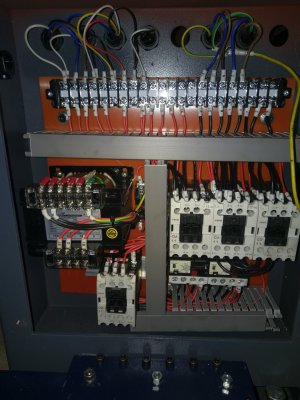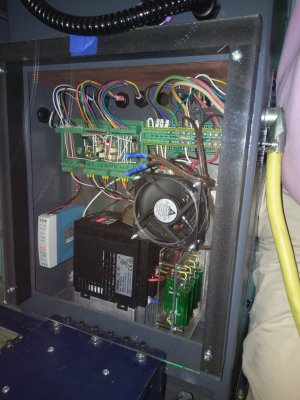- Joined
- Dec 10, 2023
- Messages
- 4
Converting a new 1440TL to VFD (Hitachi WJ200-075LF) and was considering replacing the entire electric enclosure with one that would fit the VFD. The current panel measures ~24"H x ~20"W x ~5.75"D, with the VFD ~10.25"H x ~5.5"W x 6.25"D, so there is no way to fit it in. Since the conversion replaces the contractors and most of the wiring will be replaced, removing the current enclosure and putting a ~30"H x ~20"W x ~10"D would provide enough space to mount the VFD, new relays, etc...
That size enclosure in steel is ~$400, fairly expensive for what it is - getting halfway through and realizing it won't work would be painful. Does anyone have any experience doing an enclosure swap like this? Any reason this would be a bad idea? I've bee trying to find what enclosure size does't require a fan and vent with no luck, but I have found plenty of notes that smaller enclosures don't so I assume it would be fine; I can always add a fan in the future if needed. The lathe is not against a wall, and there isn't a good place to place a second enclosure, either freestanding or on the machine.
The new enclosure would stick up about 6 inches higher than the current one, which is flush with the gearbox. The extra space provides a location to potentially mount a tachometer on the backside, facing the front. I am fine if it just sticks up a bit regardless. I could get an enclosure the same height (or close) and just deeper for the VFD to mount if there is enough room otherwise; the current panel is fairly full and being my first conversion, a little extra space would make it easier.
If replacing the enclosure is a bad idea, where have others mounted the VFD and any extra items in a standalone lathe? I looked at the space under the gearbox with the motor, but eliminated it as too cramped (and a bit of a hack).
Thanks
Brian
That size enclosure in steel is ~$400, fairly expensive for what it is - getting halfway through and realizing it won't work would be painful. Does anyone have any experience doing an enclosure swap like this? Any reason this would be a bad idea? I've bee trying to find what enclosure size does't require a fan and vent with no luck, but I have found plenty of notes that smaller enclosures don't so I assume it would be fine; I can always add a fan in the future if needed. The lathe is not against a wall, and there isn't a good place to place a second enclosure, either freestanding or on the machine.
The new enclosure would stick up about 6 inches higher than the current one, which is flush with the gearbox. The extra space provides a location to potentially mount a tachometer on the backside, facing the front. I am fine if it just sticks up a bit regardless. I could get an enclosure the same height (or close) and just deeper for the VFD to mount if there is enough room otherwise; the current panel is fairly full and being my first conversion, a little extra space would make it easier.
If replacing the enclosure is a bad idea, where have others mounted the VFD and any extra items in a standalone lathe? I looked at the space under the gearbox with the motor, but eliminated it as too cramped (and a bit of a hack).
Thanks
Brian




